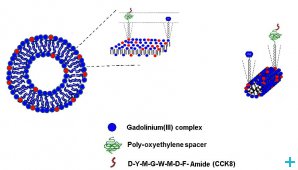Towards a new tumour-specific contrast agent for MRI applications
By Luigi Paduano 14.02.2013
Nowadays, it is estimated that cancer is responsible for about 25% of all deaths in industrialised countries, 8 million people worldwide. Scientific research is currently studying novel strategies (including drugs, therapies and devices) able to be successfully used in medicine, when early diagnosis and/or techniques like radiation therapy, immunotherapy, chemotherapy, etc. have proved to be ineffective.
Potentiating cancer detection at early stages
With the aim of developing both diagnostic and therapeutic devices, research groups from the “Università degli Studi di Napoli Federico II” have investigated about supramolecular aggregates formed by peptides as well as a new set of Gadolinium-based contrast agents for Magnetic Resonance Imaging (MRI), namely a non-invasive medical diagnostic procedure capable of giving high-quality images of the inside of the human body.
Supramolecular aggregates allow cancer detection at early stages, through the recognition by the peptide that leads to a selective accumulation in some cancer tissues. The physico-chemical characterisation of the obtained nanodevices has been carried out through several techniques (dynamic light scattering, electron miscroscopy), including small-angle neutron scattering (SANS) with the instruments KWS1 and KWS2 of the Jülich Centre for Neutron Science (JCNS) at the FRM II, under the NMI3 access activities. In particular, SANS has allowed getting structural information on both size and shape of aggregates.
Results and conclusions
The overall results of the investigations have shown the ability of the aggregates to recognise specific cells that overexpress cholecystokinin receptors and behave differently depending on the pH. These receptors are overexpressed in certain human tumours, i.e. for some tumours, ill cells have on their outer membrane a higher number density of these receptors if compared to healthy cells.
This scenario opens new opportunities for the development of diagnostic and/or therapeutic systems for the treatment of cancer pathologies.
Luigi Paduano is a Full Professor of Physical Chemistry at the Department of Chemical Sciences of the University of Naples Federico II. This research was carried out together with Gaetano Mangiapia, Gerardino D’Errico, the group of Prof. Morelli from the University of Naples and Dr. Luigi Aloij of the Fondazione Pascale, Italy
Original publications
- Paduano L., Vaccaro M., Radulescu A., Frielinghaus H., Sartorio R. (2009). Soft Matter, 5(13), 2504-2512.
- Accardo A., Mansi R., Morisco A., Mangiapia G., Paduano L., Tesauro D., Radulescu A., Aurilio M., Aloj L., Arra C. (2010). Mol. BioSyst., 6(5), 878-887.
- Accardo A., Tesauro D., Morisco A., Mangiapia G., Vaccaro M., Gianolio E., Heenan R. K., Paduano L., Morelli G. (2009) J. Biol. Inorg. Chem., 14(4), 587-599.
- Vaccaro M., Mangiapia G., Accardo A., Tesauro D., Gianolio E., Frielinghaus H., Morelli G., Paduano L. (2008) Colloid. Polym. Sci., 286(14-15), 1643-1652.
- Accardo A., Tesauro D., Aloj L., Tarallo L., Arra C., Mangiapia G., Vaccaro M., Pedone C., Paduano L., Morelli G. (2008). ChemMedChem, 3(4), 594-602.
For a more complete description, please read Issue 4 of our newsletter.

